
Pterocarpus angolensis is a species of Pterocarpus native to southern Africa, in Angola, Mozambique, Namibia, South Africa, Swaziland, Tanzania, Zaire, Zimbabwe, and Zambia. It is a protected tree in South Africa. The name Kiaat, although Afrikaans, is sometimes used outside South Africa as well. In Zimbabwe, depending on what region you are in, it is known as Mukwa or Mubvamaropa.
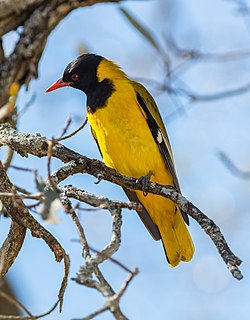
The black-headed oriole is a species of bird in the family Oriolidae. It is found in Africa and has a very striking appearance with a bright yellow body, contrasting black head and flesh-coloured beak.

The white-browed sparrow-weaver is a predominantly brown, sparrow-sized bird found throughout central and north-central southern Africa. It is found in groups of two to eleven individuals consisting of one breeding pair and other non-reproductive individuals.

The grey go-away-bird, also known as grey lourie, grey loerie, or kwêvoël, is a bold and common bird of the southern Afrotropics. They are present in arid to moist, open woodlands and thorn savanna, especially near surface water. They regularly form groups and parties that forage in tree tops, or dust bathe on the ground. Especially when disturbed, they make their presence known by their characteristically loud and nasal "kweh" or "go-way" calls, with the last syllable typically a descending drawl. Within range, their unique combination of appearance and habits precludes confusion with other bird species.
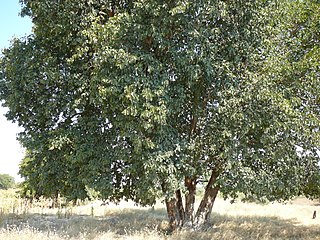
Baikiaea plurijuga, known as African teak, Mukusi, Rhodesian teak, Zambian teak or Zambesi redwood, is a species of Afrotropical tree from the legume family, the Fabaceae from southern Africa.

The coppery-tailed coucal is a species of cuckoo in the family Cuculidae. It is found in Angola, Botswana, the Democratic Republic of the Congo, Malawi, Namibia, Tanzania, Zambia, and Zimbabwe. It was first described by the German ornithologist Anton Reichenow in 1896.

The white-browed robin-chat, also known as Heuglin's robin, is a species of bird in the family Muscicapidae. Found in east, central and southern Africa, its natural habitats include riverine forest and thickets, and it is also found near humans. The IUCN classifies it as a least-concern species.

The white-bellied sunbird, also known as the white-breasted sunbird, is a species of bird in the family Nectariniidae. It is found in Angola, Botswana, Democratic Republic of the Congo, Malawi, Mozambique, Namibia, South Africa, Swaziland, Tanzania, Zambia, and Zimbabwe.
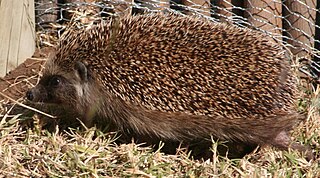
The Southern African hedgehog is a species of mammal in the family Erinaceidae. It is found in Angola, Botswana, Lesotho, Namibia, South Africa, Tanzania and Zimbabwe.

The Peters's epauletted fruit bat is a species of megabat in the family Pteropodidae. It is found in Angola, Botswana, Democratic Republic of the Congo, Malawi, Mozambique, Namibia, Swaziland, Tanzania, Zambia, and Zimbabwe. Its natural habitat is in riverine or evergreen forest, or moist woodland, where there are fruit-bearing trees.

Gonialoe dinteri, the Namibian partridge aloe, is a species of flowering plant in the Asphodelaceae family. It is native to arid areas of Angola and Namibia.

Angolan mopane woodlands are situated in southwestern Angola, extending into northern Namibia. This ecosystem surrounds Etosha Pan, which is considered a separate ecoregion. The mopane trees are the main type of vegetation.
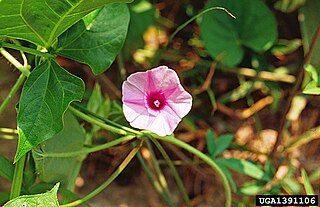
Ipomoea heptaphylla, sometimes known as Wright's morning glory in the United States, is a species of morning glory. It is incorrectly classified as I. wrightii in American publications, but is incorrectly known as I. tenuipes in Africa and India. It is an annual or short-lived perennial vine which climbs using twining stems, and has pink or purple flowers. The leaf shape is somewhat variable, with individuals possessing compound leaves palmately divided into five leaflets, and lanceolate-leaved individuals occurring in neighbouring populations. The name heptaphylla actually means 'seven-leaved'. This plant has a very extensive distribution, from Texas and adjacent states in the southeastern USA to Misiones in northern Argentina, the Greater Antilles of the Caribbean, India, Sri Lanka and East and Southern Africa. Despite its wide distribution it is uncommon throughout its range. The rediscovery of the presence of the species in India after an absence of over half a century was published in 2014. The species appears to favour dry subtropical to tropical habitats.

The papermouth, also known as the silverfish is a species of ray-finned fish in the genus Enteromius.
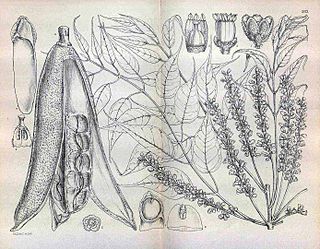
Entandrophragma caudatum, or mountain mahogany, is a large Southern African tree belonging to the mahogany family and found in eastern and north eastern South Africa, Swaziland, Botswana, Angola, the Caprivi Strip region of Namibia, Zimbabwe, Zambia and Malawi. Kew currently recognises 12 other species of Entandrophragma, all with a tropical and sub-tropical African distribution.
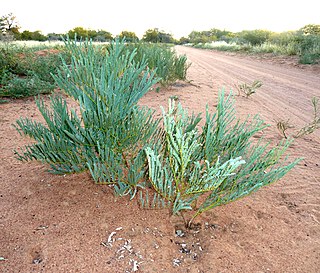
Elephantorrhiza elephantina, commonly known as the eland's wattle or elephant's root, is a subshrub in the mimosoid clade of legumes. They occur widely and in several bioregions of southern Africa. Considerable size variation has been noted, and polyploidy was suspected.

Dracaena mannii Baker or small-leaved dragon tree, is a small to medium-sized tree, though recorded up to 30 m tall with stem to 2 m in diameter in Cameroon and Gabon. It occurs from Senegal to Angola along the African west coast, is widespread in tropical Africa and is found along the African east coast from Kenya to Kosi Bay in northern KwaZulu-Natal. It prefers lowland, submontane and montane forests which are either moist and evergreen, swampy or on coastal dunes. It is also found along forest edges, in clearings and on river banks from sea level to 1,800 metres. It is one of some 120 species currently recognised, which occur primarily in Africa and southern Asia with a single vagrant species in Central America. The species is named after Gustav Mann (1836–1916), a German botanist, who corresponded with John Gilbert Baker.
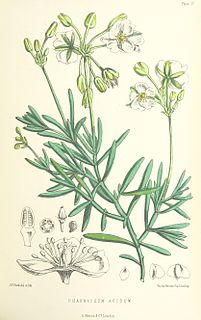
Kewa is a genus of flowering plants, consisting of eight species of succulent sub-woody plants, native to eastern and southern Africa, including Saint Helena and Madagascar. These are small shrubs or herbs that form cushions and have edible, acid-tasting leaves. Kewa is the only genus in the family Kewaceae.

The southern giraffe, also known as two-horned giraffe, is a proposed species of giraffe native to Southern Africa. However, the IUCN currently recognizes only one species of giraffe with nine subspecies.

Elephantorrhiza burkei, commonly known as the elephant root or sumach bean, is a deciduous shrub or small tree in the mimosoid clade of legumes. It is native to southern Africa, where it is found on rocky slopes or ridges, in either woodland, grassland or scrubland. The species is named after the botanist Joseph Burke.



















